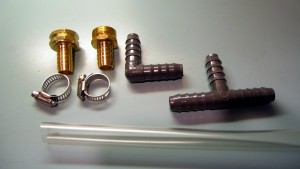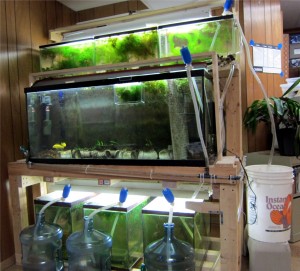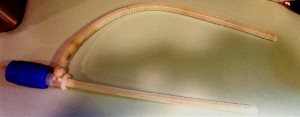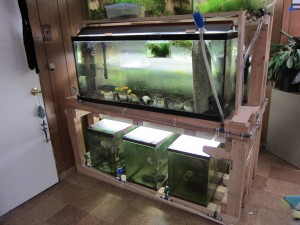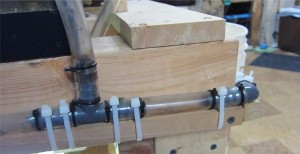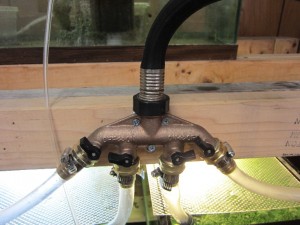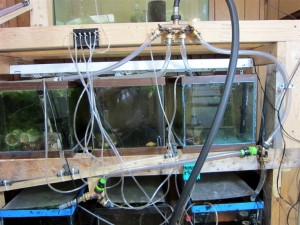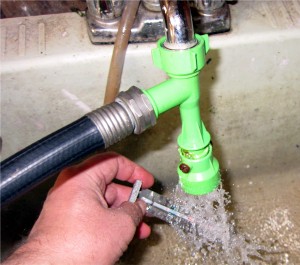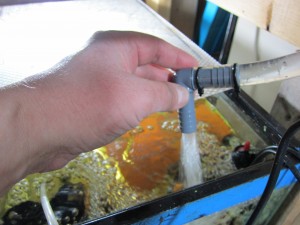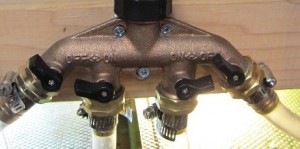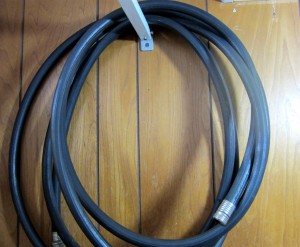If you really want to keep a lot of aquariums, you need a way to speed up water changes. Some hobbyists choose to automate the process. Usually, this involves drilling holes in the aquarium glass, and plumbing lines of pipe between the faucet and a floor drain.
Unfortunately, my tanks aren’t located anywhere near a floor drain, so I designed a simple system to drain a lot of tanks simultaneously and then to refill them all at once. The system uses kerosene siphons, 5/8” plastic tubing and fittings, garden hose, and garden manifolds. When I’m finished with water changes, I roll the hoses up and store them out of the way.
To start a water change, I drain several tanks into five gallon water jugs or buckets. In the summer, I carry the bottles and buckets outside, and pour the old tank water onto the flower beds or tomato plants. If five gallons of water is too much for you to lift, you can stop the siphons when the containers are only part way full.
The siphons are easy to come by. If your local hardware store doesn’t have any, you can order them online.
To keep from siphoning up little fish, you can fit the siphon intake tube with an old filter intake.
 When I designed the system, I installed a network of drainage tubing. My idea was to run a hose from the drainage network to a floor drain in the sub basement. Because I don’t have any idea of how to actually calculate water flow rates, however, the idea didn’t completely pan out and the system can only drain one tank at a time. Still, it helps, and means lifting one less container of old tank water.
When I designed the system, I installed a network of drainage tubing. My idea was to run a hose from the drainage network to a floor drain in the sub basement. Because I don’t have any idea of how to actually calculate water flow rates, however, the idea didn’t completely pan out and the system can only drain one tank at a time. Still, it helps, and means lifting one less container of old tank water.
The drainage tubing is held in place with plastic cable ties. I used plastic fittings–the tees and elbows–to join the different lines of drainage tubing together.
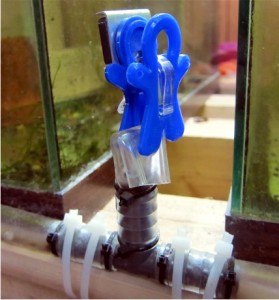
When I designed the drainage system, I didn't anticipate the back flow of water out of the input tubes. Now, when I use the system, I pinch the drainage tubes shut with these hardware store magnet clips to prevent flooding my basement.
- All the drainage tubes lead to a brass valve at the bottom of the rack. When I’m using the system, I attach a drainage hose to the brass valve…
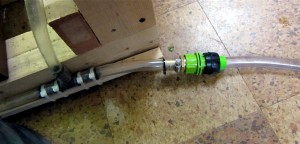 …and snake the hose down to the floor drain in the sub basement.
…and snake the hose down to the floor drain in the sub basement.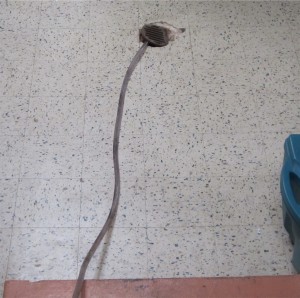
The refill system is a lot simpler and a lot more effective than the drainage system turned out to be. Basically, I used garden hose manifolds and brass fittings to convey a network of plastic hosing into each tank.
Additional manifolds divert water to the remaining tanks. Here’s my smaller tank rack. (The manifold system on this rack was a lot simpler and easier to photograph than the one on the big rack, which runs from back, to front, down the side, and back to the front again.)
I ran out of garden hose fittings so I used a length of hose from a commercial aquarium siphon. The other line of hoses in the above photo is for the drainage system.
To fill up the tanks after a water change, I attach one end of the garden hose to the top manifold and the other end to the sink, using a fitting from the commercial siphon. Then, I adjust the hot and cold settings on the faucet, and refill the tanks when the temperature is right.
Here’s one of the tanks filling with water:
The tanks don’t fill up evenly. Using the levers on the manifolds, I shut off water flow sequentially to each tank as the water level approaches the top.
Unlike PVC pipes hooked up to the faucet, I can roll the hose up and store it when I’m finished.

